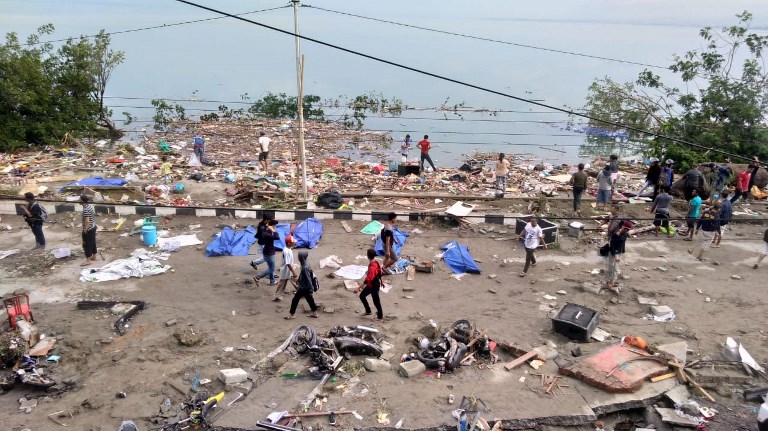by Harry Pearl
Nearly 1,400 people are now known to have died in the quake-tsunami that smashed into Indonesia’s Sulawesi island, with UN officials warning needs are “vast” for both desperate survivors and rescue teams still searching for victims.
Almost 200,000 people want urgent help, the UN’s humanitarian office said, among them tens of thousands of children, with an estimated 66,000 homes destroyed or damaged by the 7.5-magnitude quake and the tsunami it spawned.
Survivors are battling thirst and hunger, with food and clean water in short supply, and local hospitals are overwhelmed by the number of injured.
“The sense from the teams all working there… is one of real frustration,” Jens Laerke, from the UN’s humanitarian office, told reporters in Geneva late Tuesday.
“There are still large areas of what might be the worst-affected areas that haven’t been properly reached, but the teams are pushing, they are doing what they can.”
In the hard-hit city of Palu, which was trashed by tsunami waves that swept away people, cars and houses, police officers fired warning shots and tear gas on Tuesday to ward off people ransacking shops.
As survivors pick through the shattered remains of their neighbourhoods, they find more and more bodies.
“The death toll is now 1,374, 113 missing,” Willem Rampangilei, head of Indonesia’s national disaster agency, told reporters in Palu on Tuesday.
“And there are still a few bodies trapped under the rubble. We don’t know how many. Our priority is still to find and save people,” he added.
– Body bag shortage –
Authorities are expecting the number of dead to continue rising as rescuers make contact with previously cut off areas.
The Indonesia-based ASEAN Coordinating Centre for Humanitarian Assistance said that more body bags were “urgently” needed as fears grow that decomposing corpses could provide a breeding ground for deadly diseases.
Rescue efforts have been hampered by a lack of heavy machinery, severed transport links, the scale of the damage, and the Indonesian government’s initial reluctance to accept foreign help.
The Indonesian military is leading the rescue effort, but following a reluctant acceptance of help by President Joko Widodo three days after the quake struck, international NGOs also now have teams on the ground in Palu.
International aid offers have picked up since Jakarta asked for help. Late Tuesday the UN’s Central Emergency Response Fund said it was releasing $15 million in aid.
“The Government of Indonesia is experienced and well-equipped in managing natural disasters, but sometimes, as with all other countries, outside help is also needed,” Mark Lowcock, the UN’s Emergency Relief Coordinator, said in a statement.
On Wednesday, Australia also announced it was sending a medical team to the disaster zone and was providing an additional $5 million in aid.
Despite official assurances, desperation was evident on the streets of Palu, where survivors clambered through wreckage hunting for anything salvageable.
– ‘We need food and water’ –
Others crowded around daisy-chained power strips at the few buildings that still have electricity, or queued for water, cash or petrol being brought in via armed police convoy.
“The government, the president have come here, but what we really need is food and water,” Burhanuddin Aid Masse, 48, told AFP.
Queues to get a few litres of petrol lasted more than 24 hours in some places.
Sanitation is also a growing problem. “People everywhere want to go to the toilet but there’s no toilet. So we do it along the road at night,” said 50-year-old Armawati Yarmin.
Palu’s port, a key transit point for aid, has been damaged.
Berths for ships survived the quake but many of the cranes and equipment that would be needed to quickly offload supplies were toppled by the tremors, the UN said.
There are fears many of the more remote communities are missing out on the immediate aid response which has focused on Palu.
Along the road to Donggala — a large town close to the epicenter of the quake — there were more scenes of destruction. The town itself appeared relatively unscathed, but in the worst affected areas it was difficult to find a single vertical surface.
Donggala resident Farid, aged 48, pleaded for help: “Don’t center all the aid on Palu,” he said. “We in Donggala have nothing.”
Indonesia is no stranger to natural disasters.
It sits along the Pacific “Ring of Fire”, the world’s most tectonically active region, a location that lends the archipelago stunning volcanic scenery and fertile soils.
But its 260 million people remain hugely vulnerable to earthquakes, tsunamis and volcanic eruptions.
A massive 2004 quake triggered a tsunami that killed 220,000 throughout the region, including 168,000 in Indonesia alone.




